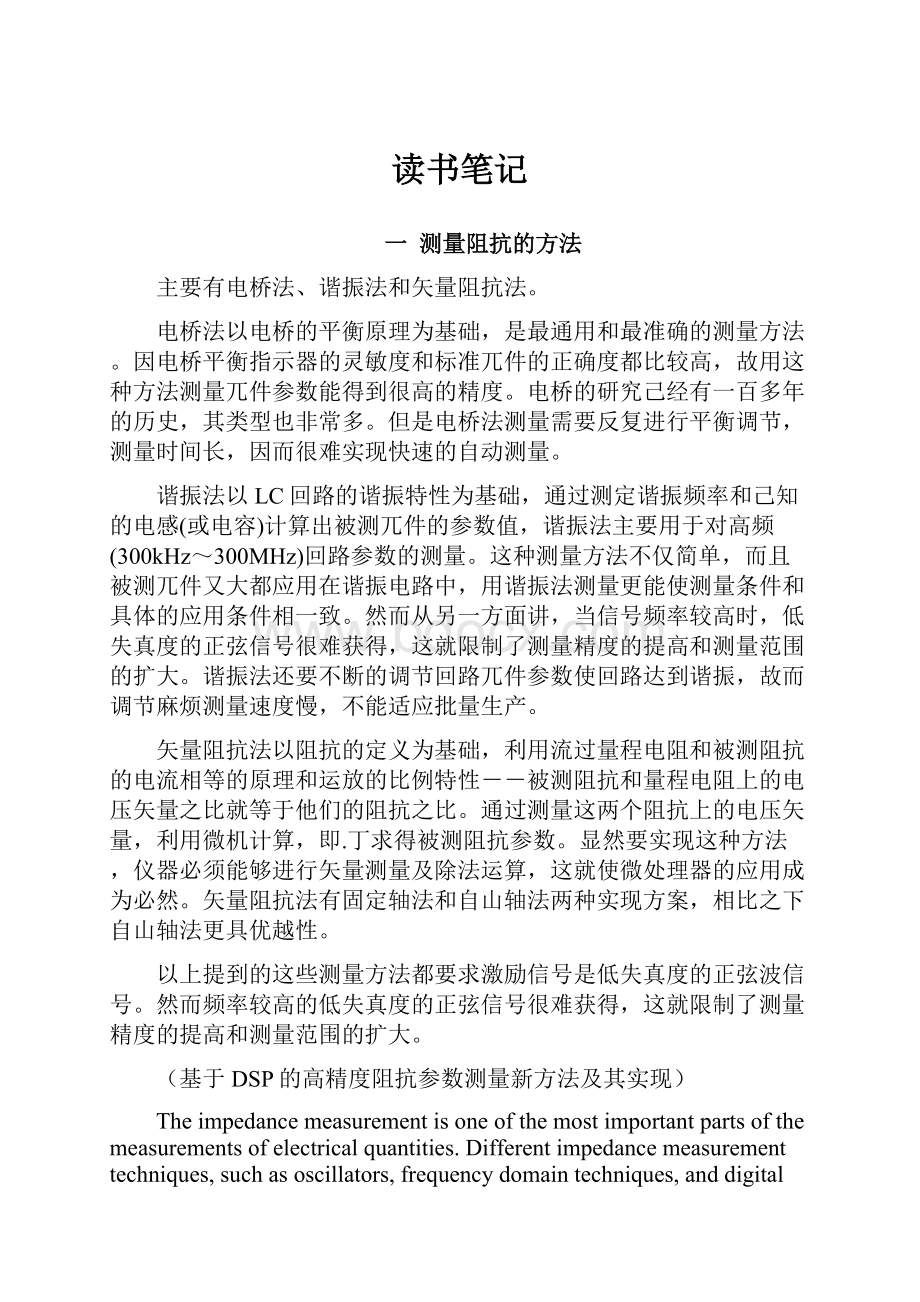读书笔记.docx
《读书笔记.docx》由会员分享,可在线阅读,更多相关《读书笔记.docx(23页珍藏版)》请在冰豆网上搜索。

读书笔记
一测量阻抗的方法
主要有电桥法、谐振法和矢量阻抗法。
电桥法以电桥的平衡原理为基础,是最通用和最准确的测量方法。
因电桥平衡指示器的灵敏度和标准兀件的正确度都比较高,故用这种方法测量兀件参数能得到很高的精度。
电桥的研究己经有一百多年的历史,其类型也非常多。
但是电桥法测量需要反复进行平衡调节,测量时间长,因而很难实现快速的自动测量。
谐振法以LC回路的谐振特性为基础,通过测定谐振频率和己知的电感(或电容)计算出被测兀件的参数值,谐振法主要用于对高频(300kHz~300MHz)回路参数的测量。
这种测量方法不仅简单,而且被测兀件又大都应用在谐振电路中,用谐振法测量更能使测量条件和具体的应用条件相一致。
然而从另一方面讲,当信号频率较高时,低失真度的正弦信号很难获得,这就限制了测量精度的提高和测量范围的扩大。
谐振法还要不断的调节回路兀件参数使回路达到谐振,故而调节麻烦测量速度慢,不能适应批量生产。
矢量阻抗法以阻抗的定义为基础,利用流过量程电阻和被测阻抗的电流相等的原理和运放的比例特性--被测阻抗和量程电阻上的电压矢量之比就等于他们的阻抗之比。
通过测量这两个阻抗上的电压矢量,利用微机计算,即.丁求得被测阻抗参数。
显然要实现这种方法,仪器必须能够进行矢量测量及除法运算,这就使微处理器的应用成为必然。
矢量阻抗法有固定轴法和自山轴法两种实现方案,相比之下自山轴法更具优越性。
以上提到的这些测量方法都要求激励信号是低失真度的正弦波信号。
然而频率较高的低失真度的正弦信号很难获得,这就限制了测量精度的提高和测量范围的扩大。
(基于DSP的高精度阻抗参数测量新方法及其实现)
Theimpedancemeasurementisoneofthemostimportantpartsofthemeasurementsofelectricalquantities.Differentimpedancemeasurementtechniques,suchasoscillators,frequencydomaintechniques,anddigitalACbridges,etc.,havebeendevelopedinthelastdecadestosatisfytheincreasingrequirements.Forprecisemeasurements,however,thesemeasuringmethodsneedprecisemeasuringhardware[1].
Anintuitiveideaofhowtomeasuretheamplitudeandthephaseofasignalistouseapeakdetectorfortheamplitudeandaphasedetector,forinstance,basedonzerocrossings[6],forthephase.However,thisisnotagoodapproachinthecaseofbioimpedancesincetheinjectedcurrentisverylowandtheenvironmentisquitenoisy(thesamplecangeneratevoltagesbyitself).Thus,itisadvisabletousesomekindofdemodulationtorejectthenoiseortheinterferencesthatarenotinthefrequencyrangeofinterest.Generally,thebioimpedancechangesareveryslowandthisimpliesthatthefrequencyrangeofinteresthasaspectralwidthofsomeHzandiscenteredonthefrequencyofthereferencesignal.Becauseofsuchsignalfeatures,coherentdemodulation,alsocalledsynchronousdemodulationordetection,isemployedinmostcases[2]
(Instrumentationforelectricalbioimpedancemeasurements)
桥路法与解调法
Therearetwobasictechniquesformeasuringimpedanceofbiologictissue:
bridgeandphasesensitivedetectormethods.Traditionally,bridgemethods[48]havebeenthemostcommonlyused.Theirmajoradvantageishighmeasurementresolutionandaccuracy.However,measurementsarequitetimeconsuming,whichisaproblemduringin-vivoworkwheretissueimpedancechangesintimeduetoongoingphysiologicalprocesses.Recentimprovementsinthedesignofbridgesystemshavedecreasedthemeasurementtime,however,theiraccuracywasreducedtoo.
Nowadays,phasesensitivedetectormethodsaregainingpopularity.OurISdesignisbasedonphasesensitivedetectortechnique,forthefollowingreasons:
∙itsabilitytoperformaccuratemeasurementsthroughoutthefrequencyrange;
∙itsabilitytoperformfastautomatedmeasurements;and,
∙simplicityofdesignandoperation.[3]
(Chapter5)
Thebridgemethodtraditionallyhasbeenthemostpopularmethodforischemiameasurements.Thereareanumberofdisadvantagestothissystem.Thismethodistimeconsumingandincommercialmodelsoftenlackssu_cientaccuracyforphasemeasurementsinbiologicaltissue.Measurementaccuracyisalsopooratlowfrequencies[3].
(TissueIschemiaMonitoringUsingImpedanceSpectroscopy-ClinicalEvaluation)
Electricalimpedancemeasurementshavebeenwidelytostudybiologicalsystems.Thesestudiesgenerallyaimtocorrelatetheelectricalstructureorphysiologicalevents.Bothbridgeandphase-sensitivedetectorshavebeenparameterswithtissuebridgetechniquesandappliedinwitheithertwo-orfour-electrodesystems.Thecombinationmajoradvantagesofthebridgetechniquesarethehighresolutionandaccuracythatcanbeobtained.However,thesemeasurementsaretime-consumingandnotwellsuitedinsituationswhereimpedanceschangerapidly.Therefore,incaseofphysiologicalmeasurements,phase-sensitivedetectormethods(lock-inamplifiers)aregenerallyused.
(TheFour-ElectrodeResistivityTechniqueinAnisotropicMedia:
TheoreticalAnalysisandApplicationonMyocardialTissueinVivo)
Measurementoftherelationbetweenthemodulesandphaseangleofbio-impedanceandfrequency,calledbioimpedancespectroscopy,isveryinterestingandimportantforfundamentalresearchparticularlyinphysiologyandpathology,aswellasforclinical·practice.Theapplicationsofthismethodcomprisetheassessmentofextracellularandintracellularwaterinthebody[3].Anotherexampleisexaminationofbodycomposition(water,fat,bone,muscle)invariousregions[1].Thereareseveralmethodsformeasurementofmodulesandphaseangleorcomponentsofimpedance[2,4].Threetechniquesareusuallyused:
thebridgemethod;themethodbasedonmeasurementtimeshiftbetweensignalsofcurrentandvoltage;thecoherentdetectionmethod.
(Multifrequencydeviceformeasurementofthecomplexelectricalbio-impedance-designandapplication)
正交相干解调法(two-phasereferencecoherentdemodulationmethod)
Theimpedancemeasurementcircuit:
FromtheIAasinusoidalwaveformwithamplitudeandphaseproportionaltotheimpedanceofthetissueisobtained.Fordecodingthisinformation,twophasereferencecoherentdemodulationmethodisemployed[6-8].ThisisillustratedinFig.7,wheretwoin-quadratureclockssignalsmustbeusedtoperformthemultiplieroperator.TheexcitationcircuithasabandpassfilterbasedonaTTBthatimplementssimultaneouslyBPandLPfunctions,bothin90˚phaseshift[6].Thesesignalsareusedtogenerateclocksfordemodulationpurpose:
thein-phaseandin-quadratureclocks.Thisisdonebymeansoftwodifferentialcomparatersplacedineachfilteroutput(LPandBP).ForagivenphaseshiftαbetweenIandVx,whenthemultiplicationhasbeenperformed,theDClevelsobtainedatthedemodulatoroutputsareproportionaltothecos(α)andsin(α)functions,beingthesetherealandimaginarypartsofZx.Afourorderlowpassfilter,withverylowcutofffrequency(about200Hz)isnecessarytoselecttheseDCsignals.ThisfilterhasbeenimplementedbycascadingtwoTTBcircuits,withinputpairtransistorsworkinginweakinversion.Inordertoreducethecapacitorarea,biascurrentsof2nAhavebeenusedtoobtainlowtransconductancetocapacitanceratios.[4]
Weusethetwo-phasereferencecoherentdemodulationmethod[8],whichgivessimultaneouslythereal(Re(Zx))andimaginary(Im(Zx))componentofacompleximpedanceZx.
模拟解调法
相敏解调器(phasesensitivedemodulator,PSD)采用与输出激励信号同步的参考信号解调出被测信号的幅值和相位信息(或实部与虚部信息),也称为相敏检测器(phasesensitivedetector)或同步解调器(synchronousdemodulator)。
实现相敏解调可以采用模拟或数字解调技术。
模拟解调有开关解调器、模拟乘法器及我们提出的脉冲采样解调器等,相应的解调参考信号为方波、正弦波和窄脉冲。
相敏解调的最大优点是可以有效抑制与激励频率不同频的干扰及噪声,但它需要与激励信号同频、同相的解调参考信号[5]。
在生物电阻抗检测、阻抗血流图和电阻抗断层成像(EIT)中,在安全的交流电压或电流激励下,被测生物组织的电阻抗信息调制在激励信号上,通过对调制信号的幅值或相位进行测量,可以得到被测目标电阻抗的实部或虚部。
要测量调制信号的幅值和相位信息,可以采用模拟解调或数字解调技术。
模拟解调器的基本原理是将调制信号与参考信号相乘,以得到与调制信号的幅度或相位成正比的解调输出信号。
在多频生物电阻抗模拟解调技术中,广泛采用双路模拟乘法器和低通滤波器实现正交解调,获得与生物电阻抗实部及虚部相关的模拟信号,在参考信号幅值精确已知的条件下,可以求得被测生物电阻抗的实部和虚部或幅值和相位D"E。
在频带较宽时,要精确测得不同频率下参考信号的实际值较困难,常采用固定值或通过定标间接求取,从而引入了测量误差[5,6]。
在正弦交流激励进行生物电阻抗测量的系统中,常用的模拟解调技术主要基于四象限乘法器实现实部、虚部解调或幅值、相位解调。
实现原理是将与激励信号同频同相的正弦参考信号及同频正交的余弦参考信号与被测信号进行四象限相乘,被测信号、参考信号分
由上式看出,解调输出信号不仅与被测信号的幅值和相位有关,还与参考信号的幅值和相位有关。
在求取信号幅值和相位时,除了要用到解调输出信号外,还需要精确知道参考信号的幅值。
在单频系统中,参考信号的幅值可以预先测到,而多频系统中要测量所有频率点的幅值是相当困难的,一般采用对有限个频率点进行测量或通过定标的方法间接获得实际条件下的幅值,因而可以认为是已知量。
参考信号幅值已知的前提下,对上述
(1)、
(2)式进行三角函数变换可得:
由此说明,目前的正交解调方法中,参考信号幅值的测量精度直接影响被测信号幅值和相位的测量精度[6]。
相敏解调法phase-sensitivedetectionmethod
Inordertomeettherequestedcharacteristics,biologicalimpedancemeasurementsystemsshouldbebasedonthe4electrodephase-sensitivedetectionmethod[2].ThebasicideaofthisapproachispresentedinFig.1.Ifavoltageontheelectrodesisv(t)=Vcos(ω0t+θ)=Vcosθcosω0t-Vsinθsinω0t(impedancetimevariation,andnoiseareneglected),thentheresistivecomponentofthetissueimpedanceisR=Vcose/I,andreactivecomponentoftheimpedanceisX=Vsine/I.Tomeasurethesecomponents,aphase-sensitivedemodulationmethodisappliedonthemeasuredvoltageontheelectrodes(Fig.1).Demodulatedin-phaseandquadrature-phasesignalsareproportionaltotheresistiveandreactivecomponentsoftheimpedance,respectively.ThesesignalsaresampledwiththeA/Dconvertersforfurtherprocessing.[7]
AckmannandSeitz[1]havereviewedthemethodsforcomplexbioelectricimpedancemeasurement.Theseparationofin-phaseandquadratureimpedancecomponentsisusuallydonebyphase-sensitivetechniquesrelayingonanalogdemodulators.Signalsareprocessedbytwoanalogchannelsthatmustbecloselymatched;otherwise,largephaseerrorsresult(Fig.1).Eachchannelincludesananalogdemodulator,followedbyalow-passfilter,asampler,and,usually,anADC.Alternatively,asinglesamplerandADCcanbesharedbybothchannelsifananalogmultiplexerprecedesthem.[8]
Aprototypesystemwasdesignedandconstructed.Thissystemincludesafour-electrodecatheterdescribedindetailbySacrist´an(2001),andacompleximpedancespectrometerbyparalleldemodulationdescribedbyOthman(1999).ThesystemusesaPCasinterfaceandplatformforspectralprocessing.Thespectrometergeneratesanexcitationcurrentatdifferentfrequencieswithintherangeofinterest,from0.05to300kHz.Thiscurrentisinjectedintothetissuethroughtheexternalelectrodesofthecatheter(figure1).Theinternalelectrodesofthecathetermeasurethepotentialgeneratedinthetissuebytheexcitationcurrent.Areferencepotentialisalsogeneratedacrossaknownresistanceinserieswiththetissue.Theinstrumentusesthedemodulationmethodtotransfertheinformationofanyexcitationfrequencytothesamelowfrequencyforanalogue–digitalconversion,withoutlosingtheamplitudeandphasei